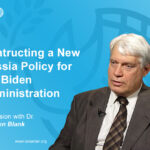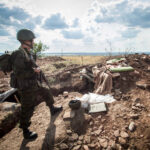Photo by The Azeri Times.
On October 8, in the midst of 2020 Karabakh war between Armenia and Azerbaijan, the Holy Savior Cathedral in Shusha, also known as the Ghazanchetsots Cathedral, was damaged by an artillery shell. Armenian officials accused Azerbaijan of targeting the religious site, but the Ministry of Defense of Azerbaijan countered this and stated that it “doesn’t target historical, cultural and, especially, religious buildings and monuments.”
As part of its post-war efforts, Azerbaijan has launched widespread initiatives to rebuild and restore the territories it gained back last year. One of Azerbaijan’s greatest victories in the Second Karabakh war was gaining control of the city of Shusha, which for many Azerbaijanis, is considered the heart of culture. Following the signing of the trilateral peace agreement by Armenia, Azerbaijan, and Russia, Azerbaijan’s Ministry of Culture stated that “the restoration and reconstruction of our historical and religious monuments, including churches and synagogues, is an integral part of the policy pursued by the Azerbaijani state in this area.”
Six months after the end of hostilities, controversy over the cathedral has erupted once more. Images of the cathedral covered in scaffolding surfaced on social media, sparking outrage in the Armenian community. By May 3, images showing the removal of the cathedral’s dome appeared, which according to Gegam Stepanyan, the Ombudsperson of the regime governing Nagorno-Karabakh, serves to “liquidate the Armenian presence and traces in the occupied territories.” Armenia’s Foreign Ministry added that the renovation efforts have started without consulting the Armenian Apostolic Church.
Azerbaijan’s Ministry of Foreign Affairs has stated that the purpose of the restoration work is to recreate the original appearance of the cathedral and the city of Shusha, adding that all works “are carried out exactly in accordance with the original architectural style.” The Baku Diocese of the Russian Orthodox Church also stated that an Orthodox church was built in Shusha in 1847, but in the 1990s, characteristics of the church were modified to add attributes of the Armenian Gregorian church.
While the government of the Republic of Azerbaijan has preserved several Armenian religious monuments, including an Armenian church in the center of Baku, the same cannot be said for Azerbaijan’s cultural monuments. Several mosques in the Armenian capital, including the Shah Abbas, Sardar, and Haji Novruz Ali mosques, were destroyed after Azerbaijanis were forced to leave Yerevan. The single remaining mosque, the Blue Mosque, was renovated to reflect a ‘Persian style.’ Mosques in Nagorno-Karabakh and the surrounding districts that survived demolition faced a similar fate. In October 2019, after five years of ‘renovation’, the Govhar Agha Upper Mosque in Shusha was reopened, and officials in Karabakh began to refer to the mosque as historically ‘Persian.’ Referring to the mosque in this way erases the Azerbaijani history and identity in Shusha, which is exactly what Armenians are accusing Azerbaijan of doing currently.
Religious and cultural sites remain a controversial and sensitive topic in the relations between Armenia and Azerbaijan. The involvement of an international organization, such as UNESCO, would be particularly valuable in building confidence and trust in the post-conflict space.
However, working with this organization will not be easy, as the Azerbaijani authorities have reasons to doubt the efficacy of UNESCO. During the 2020 Nagorno-Karabakh conflict, UNESCO issued a statement to show its concern over the escalation of violence in the region, urging Armenia and Azerbaijan to comply with their obligations, including ensuring the prevention of damage to cultural heritage under international humanitarian law. In the previous three decades of occupation of Azerbaijani territory, however, Azerbaijan’s appeals to UNESCO to investigate destruction and misappropriation of Azerbaijani cultural heritage went unanswered, and statements against the destruction of Azerbaijani cultural and religious sites were never issued.
Despite Azerbaijan’s lack of confidence in UNESCO, President Ilham Aliyev recently invited a UNESCO fact-finding mission to the territories regained in the war. According to Aliyev, “after the conflict, a mission is now expected to be sent…because on the liberated lands there is an Armenian atrocity, vandalism.”
Although dates of a field visit by UNESCO have not been announced, bringing officials from an international organization could significantly reduce tensions between Armenia and Azerbaijan. If UNESCO can verify that Azerbaijani officials are not vandalizing cultural sites belonging to Armenians, steps toward restoring trust can be taken, ultimately benefiting both peoples and leading to greater integration in the region.

